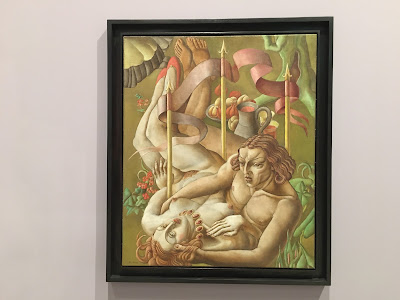The Ithell Colquohoun exhibition at Tate St Ives will finish soon and move to London; I am very glad to have had the opportunity to see it but emotionally I was more gripped by the three major exhibitions in Tate St Ives during 2024 featuring the Sami-Finnish Outi Pieski, the Portuguese Beatriz Milhazes, and the Polish-Roma Malgorzata Mirga-Tas - see these blogposts below:
https://robdonovan.blogspot.com/2024/05/exploring-new-worlds-outi-pieski-at.html
https://robdonovan.blogspot.com/2024/07/beatriz-milhazes-at-tate-st-ives.html
https://robdonovan.blogspot.com/2024/11/malgorzata-mirga-tas-polish-roma-artist.html
These three women had visions of colour and shape that took my breath away at times and always excited. Ithell Colquohoun is an English artist who came to Cornwall in search of spiritual understanding. I can admire her work but she only thrilled me with her vision occasionally. My response remained at a cerebral level most of the time.
Her story, though, is fascinating. She was an important figure in British surrealism during the 1930s and 1940s who brought her own twist to artistic work through her belief in occultism. She experimented in unconscious picture-making. Seeing the world as a connected spiritual cosmos, she came to Cornwall to explore the ancient landscape with its Celtic traditions and sacred sites. Sexual identity became a major
focus of her art as she explored the meanings of a divine feminine power. Ithell Colquohoun is an extraordinary figure in 20th century English art. Here, in this collection of images, is my brief take on the heart of her and her work: |
| Ithell Colquohoun - Self-Portrait (1929), aged 23, painted whilst a student at the Slade |
In this portrait, Ithell strikes a confident pose against a surreal background.
Following her studies, she joined spiritual groups such as the Quest Society and also the Hermetic Order of the Golden Dawn which was open to men and women as equals. Here she learned ritual magic. Ithell also travelled widely in France and across the Mediterranean. In Greece, she became infatuated with a woman called Andromaque Kazas and wrote about the experience.
 |
| This work from the 1930s is full of rich symbolism - the lesbian focus is skillfully shaped. I find emotional power in this piece. |
This next image is a rare reference to contemporary politics:
 |
| This work was inspired by nuclear bomb testing on the Bikini atoll in the Pacific circa 1950 - destructive power is illustrated with some success here, I feel. |





No comments:
Post a Comment